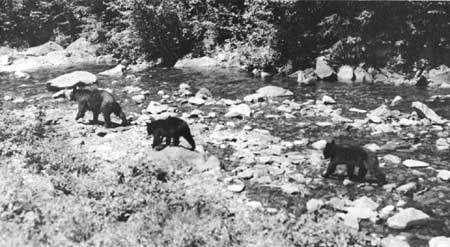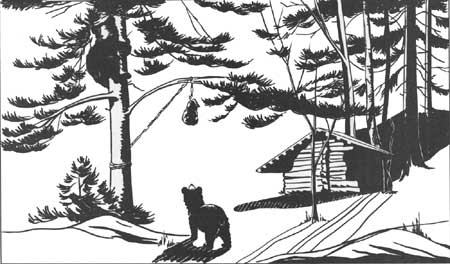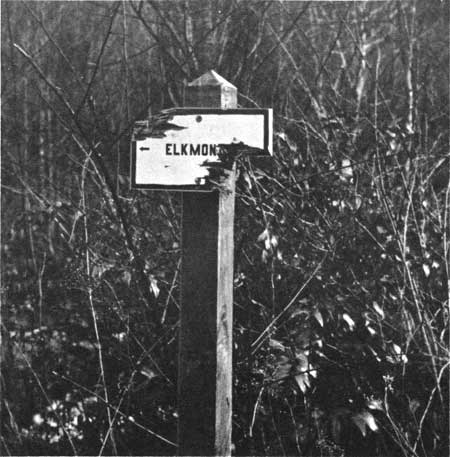|
GREAT SMOKY MOUNTAINS National Park |
 |
Bears
After your summer visit in Great Smoky Mountains National Park, the chances are you will remember the roadside or campground bears above all else. Bears are the most popular feature in a number of our National Parks, and in the Smokies, where the population of bruins runs into the hundreds, opportunities to observe these large wild animals are plentiful during the summer.
 Mother and cubs. |
Since National Parks are wildlife sanctuaries where no disturbance of the native animals is allowed, decades of protection have served to break down the wild bears' fear of man. Now, instead of depending on their own resources for a living, many bears patrol park roads and campgrounds, where they give the garbage cans a frequent going-over and where occasional food offerings, an illegal and dangerous practice, make paupers of them. Bears are usually hungry, and since they will feed on almost any kind of plants or animals, garbage is quite acceptable. Feeding them, however, represents misguided kindness; the bruins come to expect such generosity from everyone, and, consequently, trouble is imminent. Park regulations prohibit the feeding of bears, and violators are arrested. Every year, doctors located in communities near the park treat a number of cases of bear bites and bear scratches. Some of the accidents have come about as follows:
One man was occupied with feeding candy to two small cubs when the mother bear appeared and insisted upon having some of the food. Shoving the big bear aside with one hand, the man continued offering candy to the cubs when suddenly he was struck a fierce blow in the face.
One person placed his foot upon a sandwich which some careless lady tossed to the ground in front of a bear; the bite in the leg required medical attention.
A bear, prompted by the food which a lady kept offering to the animal, entered the car wherein the generous(?) person was sitting. Her efforts to coax bruin out of the car resulted in injuries.
A man, of sorts, required medical attention after he applied a lighted cigarette to a bear's nose.
Another man attempted to boost a bear into the front seat of his car so that he might take a picture of bruin sitting beside his wife, who was behind the wheel!

Hikers need not be concerned about the likelihood of an unpleasant encounter with bears along park trails, although in the vicinity of roads and campgrounds there is always the possibility of meeting a panhandling bruin who seems to know that you are carrying a lunch or a candy bar and may even insist on acquiring it. What's to be done? (One of the questions most often asked of park rangers and naturalists is, "What should I do when I meet a bear on the trail?") First, you should wave your arms and make a lot of noise. This, in the majority of instances, will deter the animal. If it doesn't, remember that he is interested not in you but in the food you are carrying, and consequently, as a last resort, throw the food away—in a direction which will cause the bear to leave the trail and permit you to walk past. Do not run! The likelihood of such an encounter is so remote that the thought of it should not prompt you to alter your plans of hiking the fine trails and seeing the attractions afoot. The great majority of park bears will give you a wide berth.
If you spend the night in one of the shelters along the Appalachian Trail, it is recommended that you suspend all food items from a tree outside the shelter in such a way that bears cannot reach them. As part of your equipment, you should have a clothesline and a net-bag such as is used for packaging oranges. Tie one end of the clothesline around a rock about the size of a hen's egg and tie the other end around the bag containing your food items; throw the rock over a horizontal tree limb and pull the bag up to a position high enough (8 feet) so that even a large bear, standing up right, could not reach it. Remember that all black bears are good tree-climbers, so don't make the mistake of suspending your food too close to the trunk of the tree or to limbs that will support the weight of one of these animals. Some overnight hikers who failed to take such precautions have spent a sleepless night.
 Bears often claw and chew coniferous trees. They also chew trailside signs. |
A mother bear with cubs should be treated with more than the usual respect. Although she may appear to be disregarding her offspring, the chances are she is quite on the alert, and it is most unwise to get between mother and babies or close to them. Even the larger and more powerful male bears appear to keep their distance from females with cubs. Unlike the bear in our storybooks, the "daddy" bruin has no hand in the rearing of the young; in fact, he is one of the few enemies which the cubs have, for cannibalism among bears is simply one more way of obtaining food.
At birth the cubs are naked, blind, and very small, weighing less than a pound apiece and measuring 6 to 9 inches in length. Usually there are two cubs and frequently, three; quadruplets are uncommon and quintuplets quite rare. Some naturalists state that the mother is 3 years old when her first-born appear; others say she is 4. Most seem to agree that the mother has cubs every second year. It is not unusual to find yearling (last year's) cubs attended by their mother up to the coming of their second summer in which case they probably shared the same winter bed. The mating season, in June and July, severs relationships between the mother and her cubs, and the latter who are now a year and a half old, are left to shift for themselves.
Do bears hibernate? The question has aroused considerable controversy, largely because the word "hibernate" has been used too loosely. Bears "den up" for long periods, usually beginning in middle or late December. Unlike jumping mice and other winter sleepers, however, they do not pass into a truly torpid condition. The normal basic rate of metabolism is maintained—the animals' temperature remains unchanged, and their respiration and heart beat are the same as in the summer. Consequently, bears cannot be regarded as true hibernators.
During the colorful autumn season, many park visitors ask the question, "Where are the bears?" Signs warning the people not to feed these animals remain posted along park roads, but few, if any, bruins remain in the vicinity of garbage cans and campgrounds. With fewer visitors, the "pickins" have been reduced proportionately. But more important is the fact that nature's various wild harvests, particularly acorns and beechnuts, are now ripe and available, and bears are doing what bears have done for unnumbered ages—feeding on mast, as these fruits are called.
For a number of years, and up to the time of World War II, "bear shows" were staged daily in some of the western National Parks, and thousands of visitors enjoyed them thoroughly. Food, usually garbage from park restaurants and hotels, was hauled to a designated area at a certain time of day. Bears were on hand in varying numbers, and a ranger or naturalist was present to tell the people about the interesting animals. Such a program, however, was more in keeping with manmade parks and zoos than National Parks, where it has long been an accepted policy that every species shall be left to carry on its struggle for existence unaided, as being to its greatest ultimate good, unless there is real cause to believe that it will perish if unassisted. The presentation of the animal life of the parks to the public shall be a wholly natural one and no animal shall be encouraged to become dependent upon man for its support. In keeping with that policy, the bear shows in all National Park Service areas were discontinued. No such shows were ever featured in Great Smoky Mountains National Park.

|

|
| NPS History | History & Culture | National Park Service | Contact |
|
Last Modified: Sat, Nov 4 2006 10:00:00 pm PST |


